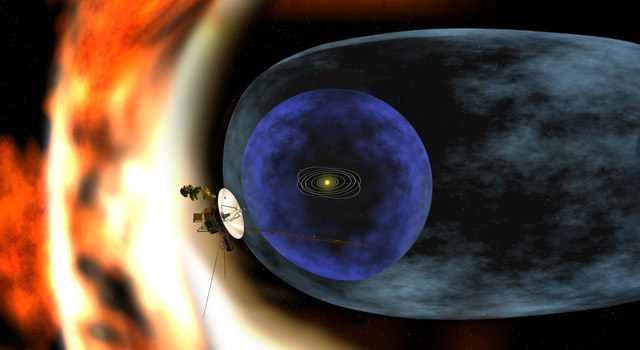[/caption]
What could be happening out near the edge of the solar system? The 33-year-old Voyager 2 spacecraft has experienced an anomaly where the data it sends back is unreadable. To try and understand the problem, engineers at JPL have shifted the spacecraft into a mode where it transmits only spacecraft health and status data. Preliminary engineering data received on May 1 show the spacecraft is basically healthy, and that the source of the issue is the flight data system, which is responsible for formatting the data to send back to Earth.
Voyager team members first noticed changes in the return of data packets from Voyager 2 on April 22, and have been working since then to troubleshoot the problem and resume the regular flow of science data. Because of a planned roll maneuver and moratorium on sending commands, engineers got their first chance to send commands to the spacecraft on April 30. It takes nearly 13 hours for signals to reach the spacecraft and nearly 13 hours for signals to come down to NASA’s Deep Space Network on Earth.
Voyager 2 is about 13.8 billion kilometers, or 8.6 billion miles, from Earth, and launched on August 20, 1977. Its twin, Voyager 1 is about 16.9 billion kilometers (10.5 billion miles) away from Earth, and launched almost two weeks after Voyager 2.
The original mission was a four-year journey to Saturn, and later the flybys of Uranus and Neptune were added to give us a “Grand Tour” of the outer solar system. If all goes well, Voyager 2 should leave the solar system and enter interstellar space in about five years.
Source: JPL


I have a theory!
Aliens discovered Voyager and now the record at the side points to Earth. Be prepared to be invaded by space aliens by 2012. LOL
It could be cosmic rays hitting the electronics.
The data is not unreadable, it’s just the aliens are asking us: Send more Chuck Berry!
To hell with Chuck Berry. But anyway I’m amazed it only takes 13 hours for the farthest probe from earth to transmit data.
Nancy,
In the second to last paragraph, it states Voyager 1 is 10.5 billion miles from Earth, with Voyager 2 8.6 billion miles from Earth, and Voyager 1 was launched almost 2 weeks after Voyager 2? How is this possible? Are the mission numbers supposed to be reversed?
On behalf of Nancy Atkinson…
Voyager 2 took a much longer path out of the solar system including a flyby of Uranus (24 Jan 86) and Neptune (25 Aug 89).
Voyager 1 made no such detour and so has travelled furthest from Earth even though it was launched later.
The article is correct 🙂 .
Hi five TerryG.
According to the linked article, the onboard computer systems have a total of 541kb, which was a wonder at the time of launch in 1977, and cost millions of dollars and super hardened. It is amazing the onboard ‘puter is still working!!! Can you imagine if it had todays’ fast PC desktop processors?!?!?
http://voyager.jpl.nasa.gov/faq.html
@star-grazer west coast
Old electronics is tougher than new – more resilient to solar storms, etc. That’s why they raid old medical equipment to refit the space shuttle rather than putting brandy-new electronics in. smaller electronics is more susceptible to the cosmic rays.
I hope they can diagnose and fix the problem. It would be such a shame to lose all of that valuable data.
Kevin:
Indeed! The Hubble Space Telescope is currently fitted with a radiation hardened 25 Mhz Intel 486 processor with 2 megabytes of RAM — hardly a powerhouse by modern computer standards, but your current Intel Dual/Quad Core processors would not last long in the harsh environment of space!
IVAN3MAN_AT_LARGE,
And people used to run desktops on similar hardware. It may seem slow but one can do quite a bit with such cpu, specially when not running graphics on it. And that’s what’s amazing, it takes so much horsepower to run today’s OSes.
@TerryG:
Thanks for the clarification. I should have remembered this…
That was scary! Hope they can do something at the meager power levels that is at hand.
[Falsely attributed to W Gates.]
I wanna see a space probe with Android on it.
ND:
Yeah, and also some of today’s Internet browsers, especially Mozilla Firefox v3.6.3 — uses up so much bloody RAM!
Jon:
See: “What would it take to put a walking robot on the Moon?“
Can you imagine if it had todays’ fast PC desktop processors?!?!?
If so, it would have died long ago. If it had Windows, the ammount of patches and updates would have overwhelmed the little probe that could.
There’s an update to this. Aparently a bit in the probe’s RAM flipped from 0 to 1.
http://news.discovery.com/space/nasa-finds-cause-of-voyager-glitch.html.